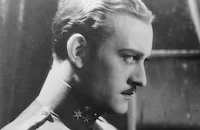The Kiss

Brief Synopsis
Cast & Crew
Jacques Feyder
Greta Garbo
Conrad Nagel
Anders Randolf
Holmes Herbert
Lew Ayres
Film Details
Technical Specs

Synopsis
Irene, victim of a loveless marriage to wealthy Guarry, carries on a clandestine affair with André, a young lawyer whom she loves but forces herself to forget; and in desperation, he leaves and goes to Paris. Pierre, the youthful son of a Lyon financier, is fascinated by Irene, and when she gives him an innocent goodby kiss, Guarry, thinking she has been unfaithful to him, attacks the boy. The ensuing struggle results in Guarry's death. Irene recounts the events of the fateful evening to the police, but her story is full of contradictions and she keeps the boy's name out of the affair. Brought to trial, she is acquitted with André's help, but later she confesses that she killed her husband to save the boy's life. At last she finds happiness with André.

Director
Jacques Feyder
Cast

Greta Garbo

Conrad Nagel
Anders Randolf

Holmes Herbert

Lew Ayres
George Davis
Crew

Videos
Movie Clip


Film Details
Technical Specs

Articles
The Kiss
In The Kiss Garbo plays Irene, a woman unhappily married to a tempestuous older businessman on the verge of bankruptcy. Irene is secretly having an affair with Andre, a young lawyer, but she refuses to leave her marriage for fear of her husband's violent temper. When Pierre, a young friend of the family's, develops a crush on Irene, an innocent kiss between them leads to tragedy.
For the character of Andre, her lover, Garbo fought hard to have Nils Asther cast in the role. Asther had already starred opposite Garbo in Wild Orchids and The Single Standard (both 1929) and was still under contract to MGM at the time. However, for reasons never understood by Garbo, MGM used Conrad Nagel instead. A casting decision that Garbo was happier about was that of newcomer Lew Ayres as her young admirer Pierre. Excited by his potential after watching his screen test, Garbo acted as a mentor to the self-proclaimed "greenhorn" and helped him with scenes along the way. Ayres was grateful for Garbo's generosity. He called her "the most sophisticated performer on the screen," and as he went on to a successful career in Hollywood, he always gave her credit for taking him under her wing.
The Kiss was not expected to do well when it was released in November 1929, right on the heels of the stock market crash that shook the world. To everyone's surprise, however, the film made a profit and eventually became the second most successful film among Garbo's silent pictures. It was behind only Flesh and the Devil, the classic romance she made with John Gilbert in 1926. Director Jacques Feyder went on to direct Garbo in the German language version of her first sound picture Anna Christie (1930) the following year.
Director: Jacques Feyder
Screenplay: Hanns Kraly
Art Direction: Cedric Gibbons
Cinematography: William H. Daniels
Costume Design: Adrian
Film Editing: Ben Lewis
Principal Cast: Greta Garbo (Irene), Conrad Nagel (Andre), Anders Randolf (Guarry), Holmes Herbert (Lassalle), Lew Ayres (Pierre Lassalle), George Davis (Durant).
BW-63m.
By Andrea Passafiume

The Kiss
Quotes
Trivia
MGM's last silent picture.
Miscellaneous Notes
Released in United States Summer June 19, 1991
Released in United States Summer June 19, 1991













